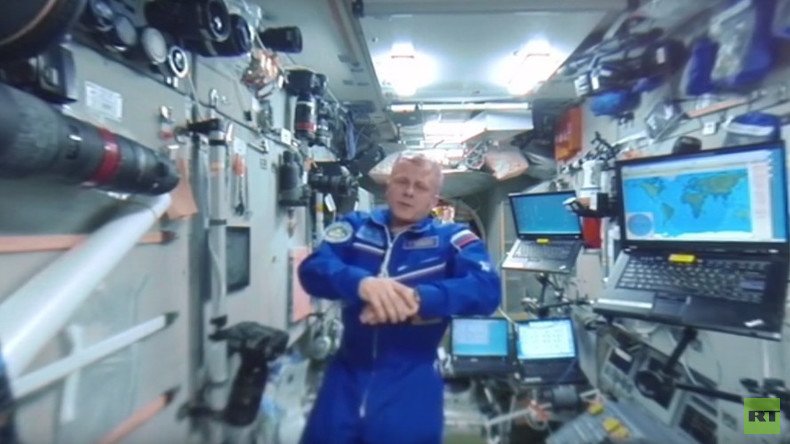RT Space 360: Visit and compare Russian & US modules on the ISS

In the latest installment of the unprecedented panoramic camera tour through the International Space Station, cosmonaut Andrey Borisenko visits two of the oldest Russian and US modules and talks about the peculiarities of the two sections of the station.
Zvezda, the Russian word for star, was the third module launched into orbit in July 2000. Unlike most US modules, which were brought in by shuttles and are sophisticated containers, Zvezda, which was delivered to orbit by a Proton rocket, and had to navigate its own way to the ISS, is a space ship in its own right. If necessary, its thrusters can even adjust the orbit of the entire station, as was done in 2007.
“Zvezda is the heart of the Russian sector of the space station,” explains Borisenko. “The service module controls all onboard systems in our sector, though when the station’s construction had just started it was responsible for running the whole of the ISS.”
Despite being built in the mid-1980s for the Mir-2 Soviet space station, which never came into being as the USSR collapsed, the 13-meter-long Zvezda contains two separate sleep stations (though it can house up to six), a medical station, a toilet, a treadmill, a wall with a picture of Yuri Gagarin and Sergey Korolev, a zone for scientific experiments, and, notably, the eating area.
“This is our space canteen, though I don’t really like the word. I prefer to call it our kitchen, one of my favorite spaces in our ‘flat,’” says Borisenko, referring to part of the house where most Russians back on Earth like to socialize while at home, as opposed to the living room traditionally favored by most Westerners.
“Here you can have a cozy sit-down and a chat, you can watch TV, or enjoy a treat from the fridge,” says the cosmonaut, who is on his second expedition to the ISS.
As well as serving as a docking port for the Progress cargo ship, divided neatly to bring separate supplies for the cosmonauts and the astronauts, the Zvezda also leads to Pirs, a docking module used for spacewalks, and Poisk, another one for incoming space ships.
Next, Borisenko takes us to the Unity module, originally named Node-1. The Boeing-built connecting module, which has six berthing locations, has spent even more time in orbit than the Zvezda, when it became the second ISS module, connecting to Zarya in December 1998.
As all the modules have to fit together, but are constructed separately, the ISS is a fascinating picture of contrasts and mirror images. Borisenko shows us the dining area in the Unity, where the US crew enjoy their own food – though cosmonauts and astronauts will sometimes trade portions out of goodwill and for variety – and English-language TV entertainment. As the Russian cosmonaut points out, Unity even has its own cargo ship, Cygnus, attached to one of the berthing places.
READ MORE: Chelsea Clinton gets hate for liking RT’s Space 360 video
While the crew spends most of its time in their own part of the ISS, where most of their daily jobs tend to be, the spacemen (and spacewomen) can move freely between the different sectors without asking for permission. In fact, as is customary when there are three Russians onboard – as now when, Borisenko, Commander Anatoly Ivanishin, and Flight Engineer Sergey Ryzhikov are all in space – one sleeps in NASA’s 4-space Harmony module. Currently, Ryzhikov is the one “living” in Harmony.
There are differences in the spaciousness, air quality and noise levels between the two parts of the ISS. For years, the Russian sector was considered louder and buzzier, while offering better views, with each sleeping compartment fit with a window into space, but since the ventilation system was replaced in 2013, the contrast is far less pronounced.
READ MORE: Space 360: RT reveals first-ever 4K panoramic view of Earth from aboard ISS
The US and Russian life support and control systems run separately from each other, though they can back each other up, and astronauts and cosmonauts are trained to use the equipment on all the modules. But thanks to the navigation and propulsion systems that are contained in the Zvezda, only the Russian part of the station could detach, and continue existing independently. While there was some talk of Russia using its orbital sectors as the foundation for a new station in the next decade, the two space agencies, Roscosmos and NASA, plan to stay in orbit together at least until 2024.
Space 360 is a collaborative project between RT, Roscosmos and Energia Rocket and Space Corporation. Videos are available in six languages at the dedicated site here.













